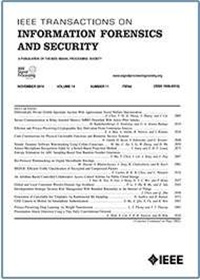水下物联网恶意软件传播的时空控制优化
IF 8
1区 计算机科学
Q1 COMPUTER SCIENCE, THEORY & METHODS
IEEE Transactions on Information Forensics and Security
Pub Date : 2025-06-11
DOI:10.1109/TIFS.2025.3578930
引用次数: 0
摘要
水下物联网(IoUT)广泛应用于数据采集、海洋勘探和防灾等领域,但也容易受到恶意软件的攻击。为了准确描述恶意软件在IoUT中传播的时空动态,本文建立了一种基于偏微分方程(PDEs)的反应扩散睡眠控制模型。针对严重感染区域,采用时空混合最优控制策略优化控制成本。首先,基于时空最优控制问题的表述,利用截断法和半群理论,得到了被控系统强解的存在性、唯一性和一些估计;然后,通过最小化序列技术验证了最优对的存在性。随后,通过证明控制-状态映射的可微性,导出了最优控制问题的一阶必要最优性条件。为了验证所提出的模型和控制方法的有效性,进行了三个比较实验研究。最后,对该方法的推广和应用进行了讨论。本文章由计算机程序翻译,如有差异,请以英文原文为准。
Spatiotemporal Control Optimization of Malware Propagation in Internet of Underwater Things
Internet of Underwater Things (IoUT), widely utilized in data collection, ocean exploration and disaster prevention, are prone to malware attacks. To accurately describe the spatiotemporal dynamics of malware propagation in IoUT, a new Reaction-Diffusion Sleep Control Model (RDSCM) based on Partial Differential Equations (PDEs) is established in this paper. To target heavily infected regions and optimize control costs, a spatiotemporal hybrid optimal control strategy is implemented. First, based on the formulation of the spatiotemporal optimal control problem, the existence, uniqueness, and some estimates of the strong solution of the controlled system are obtained using the truncation method and semigroup theory. Then, the existence of the optimal pair is verified through the minimization sequence technique. Subsequently, the first-order necessary optimality condition for the optimal control problem of PDEs is derived by proving the differentiability of the control-to-state mapping. To validate the effectiveness of the proposed model and control methodology, three comparative experimental studies are conducted. Finally, some discussions are provided on the extension and application of the proposed method.
求助全文
通过发布文献求助,成功后即可免费获取论文全文。
去求助
来源期刊

IEEE Transactions on Information Forensics and Security
工程技术-工程:电子与电气
CiteScore
14.40
自引率
7.40%
发文量
234
审稿时长
6.5 months
期刊介绍:
The IEEE Transactions on Information Forensics and Security covers the sciences, technologies, and applications relating to information forensics, information security, biometrics, surveillance and systems applications that incorporate these features
 求助内容:
求助内容: 应助结果提醒方式:
应助结果提醒方式:


